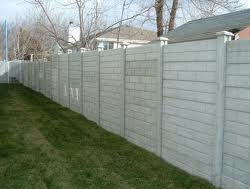Concrete fencing is just one of many fence options available for today's consumers. One of the biggest benefits of installing concrete fencing is that the concrete itself can be poured into any kind of mold. By using the right mold, the concrete can be formed in such a manner that resembles other materials like wood or stone. This feature will help you achieve a great look at a cheap price. There are several kinds of concrete fencing that people seem to purchase the most. These styles include:

* Concrete blocks
* Poured concrete
* Precast panels.
Some concrete fencing already comes precast in order to simulate the appearance of other materials. This is done to achieve a certain aesthetic value. Concrete panels are usually shipped to the purchaser; the installer can easily put them into place. Some people even paint the panels for decorative purposes. If you want to save money, concrete blocks are the cheapest option. They are also the easiest out of all three concrete fencing types to install.
Concrete Block Fencing
In places where moisture control, privacy and strength are major concerns for the fence, it is best to install concrete block fencing. This type of concrete fencing consists of small, versatile blocks that are relatively simple to put into place. In addition, concrete blocks are suitable for small building foundations and walls that must be built in damp areas because concrete is resistant to mold and corrosion.
However, concrete block fencing is not the most attractive in terms of appearance. Because plain blocks are boring and drab, a lot of people decide to cover the concrete with a finishing material like vinyl siding or stucco.
Poured Concrete Fencing
Out of all three types of concrete fencing, the poured version is the least used because the building process is cumbersome and requires the molds to be created on site. While poured concrete can be utilized for a fence, most people use this process for constructing foundations. Similar to cinder block fences, poured concrete fences tend to appear dull, which means most people will cover them with a finishing layer.
When used for fencing, the concrete can be mixed by hand. However, for tall or long fences, it is best to use a motorized or mechanical mixer because the fence will require a large amount of concrete.
Precast Concrete Panel Fencing
By far, precast panels are the most aesthetically pleasing types of concrete fencing. This type of concrete fence is fashioned one piece at a time by using prefabricated panels. These panels are designed to simulate the appearance of materials such as:
* Brick
* Stone
* Wood.
Since concrete panels are pre-made, they usually require no further treatment after they are installed. So once the concrete fencing is set into place, there is no need to apply a finishing material. Be advised that concrete panels are the most pricey option out of all three concrete fence types. In addition, concrete panels must be installed by someone who has extensive carpentry or construction knowledge.
